二十 ねんご の わたし は 四十五さい です。 ハワイ に います。 わたし の うち は ちょっと ちいさい ですが、 ひろい です。 ちいさい としょかん が あります。 そして *だいどころ は おおきい カウンター が ありますから りょうり を します。 休み に フィリピン りょうり と 日本 りょうり を します。 わたし の きょうだい も りょうり を します。 毎週 わたし の きょうだい は わたし の うち へ 来ます。 いっしょ に りょうり を します。 わたし の きょうだい は *エバ ビーチ に いますが、 わたし は *カネオへ に います。 ハワイ の *オアフ の 中 で カネオへ が 一ばん すき です。 しずかな まち ですから。 いぬ が います。 いぬ は ねこ より たのしい てすが、 どちらも すき です。 毎日 わたし と いぬ は 大学 の こうえん で さんぽ を します。 この 大学 で はたらきます。 一しゅうかん に 四日 ぶん学 の クラス を おしえます。 そして アドベンチャー 本 を かきます。 わたし の 本 は ゆうめい じゃ ありませんが いい レビュー を もらいます。
いい せいかつ ですね〜
Task: 二十ねんごのわた
*Possible unfamiliar words:
だいどころ: Kitchen
エバ ビーチ: Ewa Beach
カネオへ: Kaneohe
オアフ: Oahu
ぶん学: Literature
Tuesday, December 6, 2011
Monday, December 5, 2011
Katakana Project: Literary Work (final)
この まんが は わたし の カタカナ プロジェクト です〜! (すみません、わたし は ちょっと え が じょず じゃ ありません です が たのしかった です〜!)
Please click for larger image



*ひだり から みぎ まで よんで ください。
(Please read from left to right ^^)
Vocabulary/translations:
(First strip)
いとこ: cousin
ワアアアア: happy, excited sound
フアン: Juan, a play on the sound a dog makes in Japanese, which is ワンワン
ハヤト: Hayato, in Katakana because I'm treating it as a "nickname" - he would more than likely have kanji for his name
(Second strip)
バイキング: oddly, the name for a buffet!
ワンワン: barking
ハハハ: laughing
イカ、エビ、タコ: squid, shrimp, octopus are written in katakana because specific species have kanji
ブンチャチャチャ: the sound of music
ヤホイ: akin to the English "yahoo!"
(Third strip)
バイバイ: "Bye bye"
グッスリ: the sound of heavy sleeping
アギアギ: chewing, chomping sound
Please click for larger image



*ひだり から みぎ まで よんで ください。
(Please read from left to right ^^)
Vocabulary/translations:
(First strip)
いとこ: cousin
ワアアアア: happy, excited sound
フアン: Juan, a play on the sound a dog makes in Japanese, which is ワンワン
ハヤト: Hayato, in Katakana because I'm treating it as a "nickname" - he would more than likely have kanji for his name
(Second strip)
バイキング: oddly, the name for a buffet!
ワンワン: barking
ハハハ: laughing
イカ、エビ、タコ: squid, shrimp, octopus are written in katakana because specific species have kanji
ブンチャチャチャ: the sound of music
ヤホイ: akin to the English "yahoo!"
(Third strip)
バイバイ: "Bye bye"
グッスリ: the sound of heavy sleeping
アギアギ: chewing, chomping sound
Sunday, November 27, 2011
サンクスギビングの休み
サンクスギビング の 休み は もちろん (of course) たくさん たべました! 水よう日 に きょうとふ で たべました。おさけ の ぶた の かくに を たべました。 いちばん おいしい たべもの です! とても おいしかった です! そして ビール を いっぽん と おさけ を にはい のみました。 ビール の ボトル は かわいかった です〜

それから ヂザツ (dessert?) を みつ たべました ^^; この ヂザツ は あんみつ です。 でも まちがいました です。(It was a mistake.) くろみつ アイスクリーム を ordered ですが ジンジャー の ソルベー を もらいました。 でも おいしかった と free です〜

サンクスギビング に ニュージャージー で おばあさん に 会いました。 昼ごはん は アメリカ と フィリピン りょうり でした。 しゃしん を とりませんでした から カメラ を わすれました。 ^^; あと で (afterwards) クイーンス で ともだち に 会いました。 晩ごはん で たべました。 そして 中国 の コメヂ の えいが を みました。 おもしろかった です! サンクスギビング は たべて と りょこう だけ しました。 (Thanksgiving, all I did was eat and travel! [That sentence is probably not at all grammatically correct...])
きのう の 晩ごはん は とんかつ を りょうり を しました。 むずかしくなかった です! びっくりした! (I was surprised!)

おいしかったです〜!

それから ヂザツ (dessert?) を みつ たべました ^^; この ヂザツ は あんみつ です。 でも まちがいました です。(It was a mistake.) くろみつ アイスクリーム を ordered ですが ジンジャー の ソルベー を もらいました。 でも おいしかった と free です〜

サンクスギビング に ニュージャージー で おばあさん に 会いました。 昼ごはん は アメリカ と フィリピン りょうり でした。 しゃしん を とりませんでした から カメラ を わすれました。 ^^; あと で (afterwards) クイーンス で ともだち に 会いました。 晩ごはん で たべました。 そして 中国 の コメヂ の えいが を みました。 おもしろかった です! サンクスギビング は たべて と りょこう だけ しました。 (Thanksgiving, all I did was eat and travel! [That sentence is probably not at all grammatically correct...])
きのう の 晩ごはん は とんかつ を りょうり を しました。 むずかしくなかった です! びっくりした! (I was surprised!)

おいしかったです〜!
Wednesday, November 23, 2011
Katakana Analysis Project (Final)
I've been a fan of the Takarazuka Revue Company for several years now and have not only been fascinated by the incredible productions, in which all roles are played by women (those who play male roles are called "otokoyaku," those who play female roles are called "musumeyaku," and "Top Stars" are the "stars" of each troupe), but also the variety and talk shows that the actresses, called Takarasiennes instead, choose to visit.
As I was going through some videos from several years ago, I found a number of different examples in the usage of katakana, particularly in the show "Juri no GoGo5!" It's hosted by a former Takarazuka otokoyaku, stage name Juri Sakiho (hence the title of the show) and her guests are usually Takarazuka Top Stars and some members of their troupe. Juri-san makes a great host because of her sense of humor and her likeable personality - it always sets her guests at ease, creating a really comfortable environment that almost always leads to silliness but also to very candid and enlightening stories. Because of the former - the silliness that occurs - there are always captions that highlight a funny exchange. In these captions, I noted that katakana was used many times, usually as an onomatopoeia or for foreign words. (Words most commonly put into katakana were the hair products promoted on the show, such as VO5 スパー ハード ヘア スプレー "VO5 Super Hard Hair Spray.")
However, there were two examples that I noted that did not fit under the category of onomatopoeia nor foreign word.
Example 1: Animal name, タコの人, "octopus person", Japanese TV show "Juri no GoGo5"

(Click to enlarge)
In this example, the guests had been asked to describe some quality of their Top Star, Aran Kei, pictured above. One of the shows she had done was "El Halcon," a musical on pirates based on the Aoike Yasuko manga of the same name. The movie "Pirates of the Caribbean" came up in the ensuing conversation and in this screencap, Aran Kei was teasing her troupe members by implying that they thought of her as the "octopus person," Davy Jones.
At first, I had thought that the reason why タコ was used instead of たこ was because it was combined with 人 and thus created something that was fantastical and not real, thus falling into the category of "foreign word." However, after speaking with Park-sensei, I learned that animal and plant names are often written in katakana (i.e. バラ for "rose"). In this way, katakana is used to show when one is speaking generically about an animal, as opposed to a specific type (i.e. umbrella octopus) which would most likely have hiragana/kanji.
Example 2: Nickname, アサコ, "Asako", Japanese TV show "Juri no GoGo5"
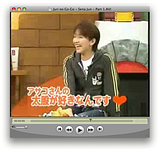
(Click to enlarge)
This example features Sena Jun, former top star of Yukigumi (Moon Troupe) and requires a little background on the Takarazuka Revue's practice in regards to names. During their time at the Takarazuka Revue Company, all Takarasiennes are known only by their stage names. Personal information such as their real name and age are actually kept secret (part of what falls under what is called the "Sumire Code") until a Takarasienne's retirement. Sena Jun retired in 2009 and her real name, Doi Asako (土井麻子), has since been released to the public.
Nicknames, however, can be derived by either a Takarasienne's real name (Sena Jun's nickname: Asako), stage name (Juri Sakiho's nickname: Juri) or something else entirely (Takumi Hibiki, former top star of Hanagumi [Flower Troupe]: Charlie, because of her bicycle). In this example, the caption is of Juri's words of praise for Sena, but she uses Sena's nickname, "Asako." I was surprised to see it written アサコ instead of あさこ simply because it's a common female name. I at first thought that because of Takarazuka's policy that Takarasiennes primarily go by their stage names, the use of katakana denoted the name as "unofficial" and linked to "foreign." However, speaking again with Park-sensei revealed that it was because her real name uses kanji and not hiragana (麻子).
The above examples show that it can be quite difficult to place definitive rules on the usage of katakana. This can explain why textbooks may explain this usage of katakana in different ways. Most note that katakana is often used for foreign words and onomatopoeia, however, some add reasons why they are used. For example, the last excerpt from our handout notes that "foreign loanwords give an impression of sophistication and modernity" and are used "even when a perfectly good native Japanese word exists." Another example spoke of the use of katakana as onomatopoeia that can both express "natural sounds (meow, bang, etc.)" and "manner (twinkle, zigzag, etc.)."
Using the information learned from the above examples, it seems that katakana can also be used to denote "general" concepts, as in the タコ example, and "informality," as in the アサコ example. This shows that even though the above examples at first seem to fit in the general katakana usage rules (namely "foreign words"), further investigation reveals that there are more intricate reasons at work. These examples along with the differences in explanations seen in textbooks show that the deliberate use of katakana can reveal deeper meanings. Knowing these subtle differences is very useful to one's learning of Japanese, adding a depth to one's understanding of katakana's role in Japanese language and culture.
As I was going through some videos from several years ago, I found a number of different examples in the usage of katakana, particularly in the show "Juri no GoGo5!" It's hosted by a former Takarazuka otokoyaku, stage name Juri Sakiho (hence the title of the show) and her guests are usually Takarazuka Top Stars and some members of their troupe. Juri-san makes a great host because of her sense of humor and her likeable personality - it always sets her guests at ease, creating a really comfortable environment that almost always leads to silliness but also to very candid and enlightening stories. Because of the former - the silliness that occurs - there are always captions that highlight a funny exchange. In these captions, I noted that katakana was used many times, usually as an onomatopoeia or for foreign words. (Words most commonly put into katakana were the hair products promoted on the show, such as VO5 スパー ハード ヘア スプレー "VO5 Super Hard Hair Spray.")
However, there were two examples that I noted that did not fit under the category of onomatopoeia nor foreign word.

(Click to enlarge)
In this example, the guests had been asked to describe some quality of their Top Star, Aran Kei, pictured above. One of the shows she had done was "El Halcon," a musical on pirates based on the Aoike Yasuko manga of the same name. The movie "Pirates of the Caribbean" came up in the ensuing conversation and in this screencap, Aran Kei was teasing her troupe members by implying that they thought of her as the "octopus person," Davy Jones.
At first, I had thought that the reason why タコ was used instead of たこ was because it was combined with 人 and thus created something that was fantastical and not real, thus falling into the category of "foreign word." However, after speaking with Park-sensei, I learned that animal and plant names are often written in katakana (i.e. バラ for "rose"). In this way, katakana is used to show when one is speaking generically about an animal, as opposed to a specific type (i.e. umbrella octopus) which would most likely have hiragana/kanji.

(Click to enlarge)
This example features Sena Jun, former top star of Yukigumi (Moon Troupe) and requires a little background on the Takarazuka Revue's practice in regards to names. During their time at the Takarazuka Revue Company, all Takarasiennes are known only by their stage names. Personal information such as their real name and age are actually kept secret (part of what falls under what is called the "Sumire Code") until a Takarasienne's retirement. Sena Jun retired in 2009 and her real name, Doi Asako (土井麻子), has since been released to the public.
Nicknames, however, can be derived by either a Takarasienne's real name (Sena Jun's nickname: Asako), stage name (Juri Sakiho's nickname: Juri) or something else entirely (Takumi Hibiki, former top star of Hanagumi [Flower Troupe]: Charlie, because of her bicycle). In this example, the caption is of Juri's words of praise for Sena, but she uses Sena's nickname, "Asako." I was surprised to see it written アサコ instead of あさこ simply because it's a common female name. I at first thought that because of Takarazuka's policy that Takarasiennes primarily go by their stage names, the use of katakana denoted the name as "unofficial" and linked to "foreign." However, speaking again with Park-sensei revealed that it was because her real name uses kanji and not hiragana (麻子).
The above examples show that it can be quite difficult to place definitive rules on the usage of katakana. This can explain why textbooks may explain this usage of katakana in different ways. Most note that katakana is often used for foreign words and onomatopoeia, however, some add reasons why they are used. For example, the last excerpt from our handout notes that "foreign loanwords give an impression of sophistication and modernity" and are used "even when a perfectly good native Japanese word exists." Another example spoke of the use of katakana as onomatopoeia that can both express "natural sounds (meow, bang, etc.)" and "manner (twinkle, zigzag, etc.)."
Using the information learned from the above examples, it seems that katakana can also be used to denote "general" concepts, as in the タコ example, and "informality," as in the アサコ example. This shows that even though the above examples at first seem to fit in the general katakana usage rules (namely "foreign words"), further investigation reveals that there are more intricate reasons at work. These examples along with the differences in explanations seen in textbooks show that the deliberate use of katakana can reveal deeper meanings. Knowing these subtle differences is very useful to one's learning of Japanese, adding a depth to one's understanding of katakana's role in Japanese language and culture.
Sunday, November 20, 2011
Katakana Project: Literary Work (draft)
Monday, November 7, 2011
さくぶん2
山田さんへ、
はじめまして。 わたし は ジェス です。 コロンビア だいがく の がくせい です。 三ねんせい です。 *ぶんがく が すき ですから わたし の せんもん は えいご です。 そして、えいご の きょうし に なりたい です。 わたし は しずか な ひと です。 まいにち 6じ に おきます。 ときどき はしります。 まいあさ あさごはん を たべます。 でも わたし は ぜんぜん りょうり が じょうず じゃ ありません から オアトミール を たべます。 月よう日 から 木よう日 まで クラス が あります。 それから、 火よう日 と 水よう日 と 木よう日 に はたらきます。 しょうがくせい に えいご を おしえます。 しょうがくせい は **よむの が すき じゃ ありません から ときどき むずかしい です が おもしろい です。 6月 に 日本 へ いきます。 これ から おせわ に なります。
どうぞ よろしく おねがいします。
Task: 山田さんにてがみをかきましょう。
*ぶんがく: Literature
**よむの: Reading
はじめまして。 わたし は ジェス です。 コロンビア だいがく の がくせい です。 三ねんせい です。 *ぶんがく が すき ですから わたし の せんもん は えいご です。 そして、えいご の きょうし に なりたい です。 わたし は しずか な ひと です。 まいにち 6じ に おきます。 ときどき はしります。 まいあさ あさごはん を たべます。 でも わたし は ぜんぜん りょうり が じょうず じゃ ありません から オアトミール を たべます。 月よう日 から 木よう日 まで クラス が あります。 それから、 火よう日 と 水よう日 と 木よう日 に はたらきます。 しょうがくせい に えいご を おしえます。 しょうがくせい は **よむの が すき じゃ ありません から ときどき むずかしい です が おもしろい です。 6月 に 日本 へ いきます。 これ から おせわ に なります。
どうぞ よろしく おねがいします。
Task: 山田さんにてがみをかきましょう。
*ぶんがく: Literature
**よむの: Reading
Monday, October 24, 2011
Katakana Analysis Project (draft)
As I was going through some old videos I'd saved of Takarazuka, I found a number of different examples in the usage of katakana, particularly in the show "Juri no GoGo5!" It's hosted by a former Takarazuka otokoyaku, stage name Juri Sakiho (hence the title of the show) and her guests are usually Takarazuka top stars and some members of their troupe. Juri-san makes a great host because of her sense of humor and her likeable personality - it always sets her guests at ease, creating a really comfortable environment that almost always leads to silliness but also to very candid and enlightening stories. Because of the former - the silliness that always occurs - there are always captions that highlight a funny exchange. In these captions, I noted that katakana was used many times, usually as an onomatopoeia or for foreign words. (Words most commonly put into katakana were the hair products promoted on the show, such as VO5 スパー ハード ヘア スプレー "VO5 Super Hard Hair Spray.") There were two examples that I noted, however, that did not fit under the category of onomatopoeia nor foreign word.
Example 1: Animal name, タコの人, "octopus person", Japanese TV show "Juri no GoGo5"

(Click to enlarge)
In this example, the guests had been asked to describe some quality of their top star, Aran Kei, pictured above. One of the shows she had done was "El Halcon," a musical on pirates based on the Aoike Yasuko manga of the same name. The movie "Pirates of the Caribbean" came up in the conversation and Aran Kei was teasing her troupe members by implying that they thought of her as the "octopus person," Davy Jones.
At first, I had thought that the reason why タコ was used instead of たこ was because it was combined with 人 and thus created something that was fantastical and not real. However, after speaking with Park-sensei, I learned that animal and plant names are often written in katakana (i.e. バラ for "rose"). It's a good way to show when one is speaking generically, as opposed to a specific type (i.e. umbrella octopus) that would most likely have hiragana/kanji.
Example 2: Nickname, アサコ, "Asako", Japanese TV show "Juri no GoGo5"

(Click to enlarge)
This example features Sena Jun, former top star of Yukigumi (Moon Troupe) and requires a little background on the Takarazuka Revue's practice in regards to names. During their time at the Takarazuka Revue Company, all Takarasiennes are known only by their stage names. Personal information such as their real name and age are actually kept secret (part of what falls under what is called the "Sumire Code") until a Takarasienne's retirement. Sena Jun retired in 2009 and her real name, Doi Asako (土井麻子), has since been released to the public.
Nicknames, however, can be derived by either a Takarasienne's real name (Sena Jun's nickname: Asako), stage name (Juri Sakiho's nickname: Juri) or something else entirely (Takumi Hibiki, former top star of Hanagumi (Flower Troupe): Charlie, because of her bicycle). In this example, the caption is of Juri's words of praise for Sena, but she uses Sena's nickname, "Asako." I was surprised to see it written アサコ instead of あさこ simply because it's a common female name. I at first thought that because of Takarazuka's policy that Takarasiennes primarily go by their stage names, the use of katakana denoted the name as "unofficial." However, speaking again with Park-sensei revealed that it was more than likely used because her real name uses kanji and not hiragana (麻子).
All of these intricacies make it quite difficult to place definitive rules on the usage of katakana. This can explain why textbooks may explain this usage of katakana in different ways. Most note that katakana is often used for foreign words and onomatopoeia, however, some add reasons why they are used. For example, the last excerpt from our handout notes that "foreign loanwords give an impression of sophistication and modernity" and are used "even when a perfectly good native Japanese word exists." Another example spoke of the use of katakana as onomatopoeia that can both express "natural sounds (meow, bang, etc.)" and "manner (twinkle, zigzag, etc.)." These explanations aren't necessarily different from each other, but simply add a depth to one's understanding of how katakana can be used.

(Click to enlarge)
In this example, the guests had been asked to describe some quality of their top star, Aran Kei, pictured above. One of the shows she had done was "El Halcon," a musical on pirates based on the Aoike Yasuko manga of the same name. The movie "Pirates of the Caribbean" came up in the conversation and Aran Kei was teasing her troupe members by implying that they thought of her as the "octopus person," Davy Jones.
At first, I had thought that the reason why タコ was used instead of たこ was because it was combined with 人 and thus created something that was fantastical and not real. However, after speaking with Park-sensei, I learned that animal and plant names are often written in katakana (i.e. バラ for "rose"). It's a good way to show when one is speaking generically, as opposed to a specific type (i.e. umbrella octopus) that would most likely have hiragana/kanji.

(Click to enlarge)
This example features Sena Jun, former top star of Yukigumi (Moon Troupe) and requires a little background on the Takarazuka Revue's practice in regards to names. During their time at the Takarazuka Revue Company, all Takarasiennes are known only by their stage names. Personal information such as their real name and age are actually kept secret (part of what falls under what is called the "Sumire Code") until a Takarasienne's retirement. Sena Jun retired in 2009 and her real name, Doi Asako (土井麻子), has since been released to the public.
Nicknames, however, can be derived by either a Takarasienne's real name (Sena Jun's nickname: Asako), stage name (Juri Sakiho's nickname: Juri) or something else entirely (Takumi Hibiki, former top star of Hanagumi (Flower Troupe): Charlie, because of her bicycle). In this example, the caption is of Juri's words of praise for Sena, but she uses Sena's nickname, "Asako." I was surprised to see it written アサコ instead of あさこ simply because it's a common female name. I at first thought that because of Takarazuka's policy that Takarasiennes primarily go by their stage names, the use of katakana denoted the name as "unofficial." However, speaking again with Park-sensei revealed that it was more than likely used because her real name uses kanji and not hiragana (麻子).
All of these intricacies make it quite difficult to place definitive rules on the usage of katakana. This can explain why textbooks may explain this usage of katakana in different ways. Most note that katakana is often used for foreign words and onomatopoeia, however, some add reasons why they are used. For example, the last excerpt from our handout notes that "foreign loanwords give an impression of sophistication and modernity" and are used "even when a perfectly good native Japanese word exists." Another example spoke of the use of katakana as onomatopoeia that can both express "natural sounds (meow, bang, etc.)" and "manner (twinkle, zigzag, etc.)." These explanations aren't necessarily different from each other, but simply add a depth to one's understanding of how katakana can be used.
Thursday, October 20, 2011
コミック コン は たのしいい でした〜!!
せんしゅうまつ は コミック コン (Comic Convention) へ いきました! とても たのしかった です!
(For the following pictures, please click to see a bigger version. If you would like to see the whole album, please click here. The password is "ahirutonihongo")
たくさん ひと! まいにち にぎやか でした。

わたし は ワン ピース の ストロングワールド の ルフィ (One Piece's Luffy, Strong World version) を "cosplay" (I don't know the verb for "dress up" o_o;;) でした。(わたし の かみ は きれい じゃありませんでした ^^;)

There were a lot of cosplayers who were super cool! かっこいい〜〜!


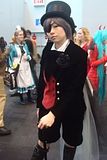
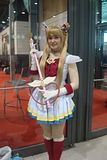


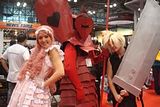

(First row, L-R: Porco Rosso, Link, Ciel, Sailormoon (Eternal!); Second row, L-R: Rocketman, I forget his name but I think he's a villain from Spiderman, Alice in Wonderland meets Cloud; Third row: One Piece - Frankie, Luffy, Zoro - わたし の なかま! XD)
There was also many things to buy!


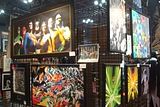
わたし は ぼし (hat) は すき です〜! でも この ぼし は ちょっと たかい でした ^^;


ワン ピース の ゾロ の figurine を かいました。 クリスマス に わたし は いもうと に あげます。 そして この まんが を かいました。 きのう の ばん よみました。 かわいい〜〜〜!
もちろん (of course) おいしい たべもの を たべました! きょとふ で ばんごはん の サンプラー (dinner sampler) と ヂザーツ の かいせき プリー フィクス (dessert Kaiseki prix fixe) を たべました。 とても おしかった!!!
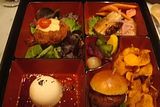
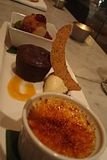
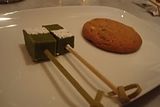
(L-R: Dinner sampler (clockwise from top left): Croquette, sake braised pork belly, tofu and chicken slider, homemade tofu); 2nd course of dessert prix fixe (from top): anmitsu, chocolate cake with ice cream and caramel, ginger creme brulee); 3rd course of dessert prix fixe: matcha chocolate and hazelnut cookie)
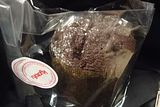
そして フリー カップケーキ (free cupcake) に もらいました! (I'm not sure if they were thanking me for being cheerful or if it was because they were impressed I ate so much, as both courses are meant for 2 people XD;;)
それから マカルーン カフェ (Macaron Cafe) で マカルーン を かいました。

(Flavors: Top row - espresso, passion fruit, caramel, mango; bottom row - strawberry rhubarb, chocolate ginger, matcha, raspberry)
So basically, last weekend was full of eating and shopping XD;;
(For the following pictures, please click to see a bigger version. If you would like to see the whole album, please click here. The password is "ahirutonihongo")
たくさん ひと! まいにち にぎやか でした。

わたし は ワン ピース の ストロングワールド の ルフィ (One Piece's Luffy, Strong World version) を "cosplay" (I don't know the verb for "dress up" o_o;;) でした。(わたし の かみ は きれい じゃありませんでした ^^;)

There were a lot of cosplayers who were super cool! かっこいい〜〜!








(First row, L-R: Porco Rosso, Link, Ciel, Sailormoon (Eternal!); Second row, L-R: Rocketman, I forget his name but I think he's a villain from Spiderman, Alice in Wonderland meets Cloud; Third row: One Piece - Frankie, Luffy, Zoro - わたし の なかま! XD)
There was also many things to buy!



わたし は ぼし (hat) は すき です〜! でも この ぼし は ちょっと たかい でした ^^;


ワン ピース の ゾロ の figurine を かいました。 クリスマス に わたし は いもうと に あげます。 そして この まんが を かいました。 きのう の ばん よみました。 かわいい〜〜〜!
もちろん (of course) おいしい たべもの を たべました! きょとふ で ばんごはん の サンプラー (dinner sampler) と ヂザーツ の かいせき プリー フィクス (dessert Kaiseki prix fixe) を たべました。 とても おしかった!!!



(L-R: Dinner sampler (clockwise from top left): Croquette, sake braised pork belly, tofu and chicken slider, homemade tofu); 2nd course of dessert prix fixe (from top): anmitsu, chocolate cake with ice cream and caramel, ginger creme brulee); 3rd course of dessert prix fixe: matcha chocolate and hazelnut cookie)

そして フリー カップケーキ (free cupcake) に もらいました! (I'm not sure if they were thanking me for being cheerful or if it was because they were impressed I ate so much, as both courses are meant for 2 people XD;;)
それから マカルーン カフェ (Macaron Cafe) で マカルーン を かいました。

(Flavors: Top row - espresso, passion fruit, caramel, mango; bottom row - strawberry rhubarb, chocolate ginger, matcha, raspberry)
So basically, last weekend was full of eating and shopping XD;;
Monday, October 10, 2011
おなかがぺこぺこです〜!*
きのう、 わたし は ごぜん 9じはん から ごご 1じはん まで としょかん に べんきょうしました。えき で おたふく (Otafuku, restaurant in East Village) に いきました。 たこやき と おこのみやき を たべました〜!

*Credit: theeatenpath.com
そして フローズン ヨグルト を たべました。 とっても おいしい です〜!
それから JAS マート に いきました。 こめ (uncooked rice) と おちゃ を かいました。 いろいろ な おちゃ は すき です。 (I like all sorts of tea :D) こんしゅう、 べんと を します。
8じ わたし の アパート に かえりました。 にほんご の しゅくだい と ピアノ を しました。
(Here are links to the guitar version and piano version of the song I'm learning, "Theme of Love" from Final Fantasy 4.)
*Phrase that translates to something like, "My tummy is grumbling!" And for me, that's pretty much all the time~

*Credit: theeatenpath.com
そして フローズン ヨグルト を たべました。 とっても おいしい です〜!
それから JAS マート に いきました。 こめ (uncooked rice) と おちゃ を かいました。 いろいろ な おちゃ は すき です。 (I like all sorts of tea :D) こんしゅう、 べんと を します。
8じ わたし の アパート に かえりました。 にほんご の しゅくだい と ピアノ を しました。
(Here are links to the guitar version and piano version of the song I'm learning, "Theme of Love" from Final Fantasy 4.)
*Phrase that translates to something like, "My tummy is grumbling!" And for me, that's pretty much all the time~
Wednesday, September 28, 2011
せんしゅう。。。
せんしゅう の きんようび は にほんご の チャット クルブ の ミーチング。 ミレーシさん と あゆみさん は はなしました。 とっても たのしい でした! たくさん の どうし は わすれました でも あゆみさん は わたし を おしえた。 つぎ の メーチング へ いきたい! (I forgot a lot of words but Millacy-san and Ayumi-san taught me. I want to go to the next meeting!)
せんしゅう の にちようび は みつわ マーケト へ いきました。 ほっかいど の フード フェシチヴァル でした。 たくさん たべた! うに と かに の おべんとう と クロケー と クレム ブレー と ブラック セサメ の アイスクリーム を たべました。 おいしかった です〜 そして パン と おにぎり と ラメン と オリオン ビール を かいました。
(Last week Sunday, I went to Mitsuwa Market. It was the Hokkaido Food Festival. I ate a lot! I ate a sea urchin and crab bento, croquette, creme brulee, and black sesame ice cream. It was very tasty! I also bought Japanese bread, onigiri, ramen, and Orion beer.)
せんしゅう は とっても たのしい でした〜!
せんしゅう の にちようび は みつわ マーケト へ いきました。 ほっかいど の フード フェシチヴァル でした。 たくさん たべた! うに と かに の おべんとう と クロケー と クレム ブレー と ブラック セサメ の アイスクリーム を たべました。 おいしかった です〜 そして パン と おにぎり と ラメン と オリオン ビール を かいました。
(Last week Sunday, I went to Mitsuwa Market. It was the Hokkaido Food Festival. I ate a lot! I ate a sea urchin and crab bento, croquette, creme brulee, and black sesame ice cream. It was very tasty! I also bought Japanese bread, onigiri, ramen, and Orion beer.)
せんしゅう は とっても たのしい でした〜!
Tuesday, September 20, 2011
The first of many food posts~
I've many favorite Japanese foods - うどん, ラメン, そば (I obviously grew up on a lot of noodles!), すし, おにぎり - but what I've been craving lately is ぱん! Japanese bread is my favorite bread~ I was lucky to work at Japonaise Bakery when I was in Boston, and they have some of the best ぱん ever~ The first time I ate their しょくぱん, I felt like I had been transported to my childhood! They also have really great pastries and cakes~ So if you ever find yourself in Boston, make sure to visit them!
Now, if only I had the money to try all the Japanese bakeries here in New York...
Now, if only I had the money to try all the Japanese bakeries here in New York...
Sunday, September 18, 2011
Wednesday, September 14, 2011
Hi~!
This is Jess from Park-sensei's class~ The title of my blog comes from an old nickname, "Ducky," which I learned early on was "ahiru" in Japanese. So if you see someone named "ducky" commenting on your posts, that's me.
The reason why I've chose to study Japanese is because of my background. I was born in Okinawa, Japan and lived most of my childhood there until I moved to Hawaii, which has a large Japanese population. Japan and its culture still holds a big place in my heart, hence why I want to be more proficient in the language. I expect that the most difficult part of this class for me will be learning new vocabulary and also kanji. Though this class may grow difficult as the semester goes on, I look forward to learning more Japanese!
The reason why I've chose to study Japanese is because of my background. I was born in Okinawa, Japan and lived most of my childhood there until I moved to Hawaii, which has a large Japanese population. Japan and its culture still holds a big place in my heart, hence why I want to be more proficient in the language. I expect that the most difficult part of this class for me will be learning new vocabulary and also kanji. Though this class may grow difficult as the semester goes on, I look forward to learning more Japanese!
こんいちわ!
はじめまして、わたし は ジェス です。わたし の ニックネーム は ”あひる” です。 コロンビア だいがく の がくせい です。さん ねん せい です。 ハワイイ から きました。にほんご は たのしい です!
どうぞ よろしく。
どうぞ よろしく。
Subscribe to:
Posts (Atom)